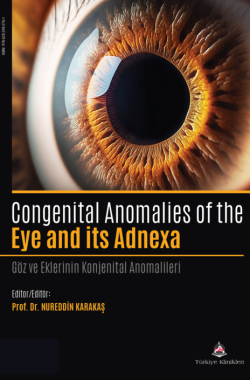Congenital Anomalies of the Iris
Emine ÇİNİCİa
aAtatürk University Faculty of Medicine, Department of Ophthalmology, Erzurum, Türkiye
Çinici E. Congenital anomalies of the iris. In: Karakaş N, ed. Congenital Anomalies of the Eye and its Adnexa. 1st ed. Ankara: Türkiye Klinikleri; 2024. p.20-4.
ABSTRACT
The iris is the anterior part of the uveal layer of the eye. It protects the retina from phototoxic effects by adjusting the amount of light entering the eye. It occurs during the 5th intrauterine week when the neural crest cells on the back surface of the cornea undergo changes. While the iris stroma develops from neural crest cells, two epithelial layers consist of neuroectodermal tissue at the edge of the optic fossa. Congenital anomalies of the iris are often seen together with anomalies of other structures of the anterior segment due to their common embryological development. For example, as in Axenfeld-Rieger syndrome and Peters anomaly. The most common congenital iris anomalies are iris colobomas, aniridia and heterochromic iris.
Keywords: Congenital abnormalities; coloboma; aniridia
Kaynak Göster
Referanslar
- Nischal KK. Pediatric Iris Abnormalities. Pediatric Ophthalmology and Strabismus. New York, NY: Springer; 2003. p.430-49. [Crossref]
- Williams AL, Bohnsack BL. Neural crest derivatives in ocular development: discerning the eye of the storm. Birth Defects Res C Embryo Today. 2015;105(2):87-95. [Crossref] [PubMed] [PMC]
- Reis LM, Maheshwari M, Capasso J, Atilla H, Dudakova L, Thompson S, ET AL. Axenfeld-Rieger syndrome: more than meets the eye. J Med Genet. 2023;60(4):368-79. [Crossref] [PubMed] [PMC]
- Bhandari R, Ferri S, Whittaker B, Liu M, Lazzaro DR. Peters anomaly: review ofthe literature. Cornea. 2011;30(8):939-44. [Crossref] [PubMed]
- Hull S, Arno G, Ku CA, Ge Z, Waseem N, Chandra A, ET AL. Molecular and Clinical Findings in Patients With Knobloch Syndrome. JAMA Ophthalmol. 2016;134(7):753-62. [Crossref] [PubMed]
- Akkaya S. Evaluation of Posterior Ocular Structures in Patients with Isolated Iris Coloboma. Beyoglu Eye J. 2020;5(3):228-33. [Crossref] [PubMed] [PMC]
- Wong MT, Schölvinck EH, Lambeck AJ, van Ravenswaaij-Arts CM. CHARGE syndrome: a review of the immunological aspects. Eur J Hum Genet. 2015;23(11):1451-9. [Crossref] [PubMed] [PMC]
- Hingorani M, Hanson I, van Heyningen V. Aniridia. Eur J Hum Genet. 2012;20(10):1011-7. [Crossref] [PubMed] [PMC]
- Landsend ECS, Lagali N, Utheim TP. Congenital aniridia - A comprehensive review of clinical features and therapeutic approaches. Surv Ophthalmol. 2021;66(6):1031-50. [Crossref] [PubMed]
- Abouzeid H, Youssef MA, ElShakankiri N, Hauser P, Munier FL, Schorderet DF. PAX6 aniridia and interhemispheric brain anomalies. Mol Vis. 2009;15:2074-83.
- Dansault A, David G, Schwartz C, Jaliffa C, Vieira V, de la Houssaye G, et al. Three new PAX6 mutations including one causing an unusual ophthalmic phenotype associated with neurodevelopmental abnormalities. Mol Vis. 2007;13:511-23.
- Grieshaber MC, Orgul S, Bruder E, Hadziselimovic F, Flammer J. Congenital iris ectropion and glaucoma associated with intestinal neuronal dysplasia: a manifestation of a neural crest syndrome. Arch Ophthalmol. 2006;124(10):1495-7. [Crossref] [PubMed]
- Wilson ME. Congenital iris ectropion and a new classification for anterior segment dysgenesis. J Pediatr Ophthalmol Strabismus. 1990;27(1):48-55. [Crossref] [PubMed]
- Ritch R, Forbes M, Hetherington J Jr, Harrison R, Podos SM. Congenital ectropion uveae with glaucoma. Ophthalmology. 1984;91(4):326-31. [Crossref] [PubMed]
- Sridhar U, Tripathy K. Iris Ectropion Syndrome. 2023. In: StatPearls [Internet]. Treasure Island (FL): StatPearls Publishing; 2024.
- Gladstone RM. Development and significance of heterochromia of the iris. Arch Neurol. 1969;21(2):184-91. [Crossref] [PubMed]
- Tomar M, Dhiman R, Sharma G, Yadav N. Artistic Iris: A Case of Congenital Sectoral Heterochromia Iridis. J Ophthalmic Vis Res. 2018;13(3):359-60. [Crossref] [PubMed] [PMC]
- Harold C. Atlas of genetic diagnosis and counseling. vol.1069. Totowa, NJ: Humana Press; 2006. p.1519-25.
- Angée C, Nedelec B, Erjavec E, Rozet JM, Fares Taie L. Congenital Microcoria: Clinical Features and Molecular Genetics. Genes (Basel). 2021;12(5):624. [Crossref] [PubMed] [PMC]
- Kurtul BE, Özer PA, Çağlar AA, Kabataş EU. Bilateral congenital mydriasis in a child case. Turk Pediatri Ars. 2016;51(3):176-7. [Crossref] [PubMed] [PMC]
- Bakbak B, Gedik Ş. Anisocoria. Turk J Ophthalmol. 2012;42(1):68-72. [Crossref]
- Kocabeyoğu S, Şekeroğlu HT, Dikmetaş Ö, Mocan MC. A case of Biateral Extensive Persistent Pupillary Membranes with Amblyopia and Cataract. Turk J Ophthalmol. 2013;43(1):70-2. [Crossref]
- Grutzmacher RD, Lindquist TD, Chittum ME, Bunt-Milam AH, Kalina RE. Congenital iris cysts. Br J Ophthalmol. 1987;71(3):227-34. [Crossref] [PubMed] [PMC]

